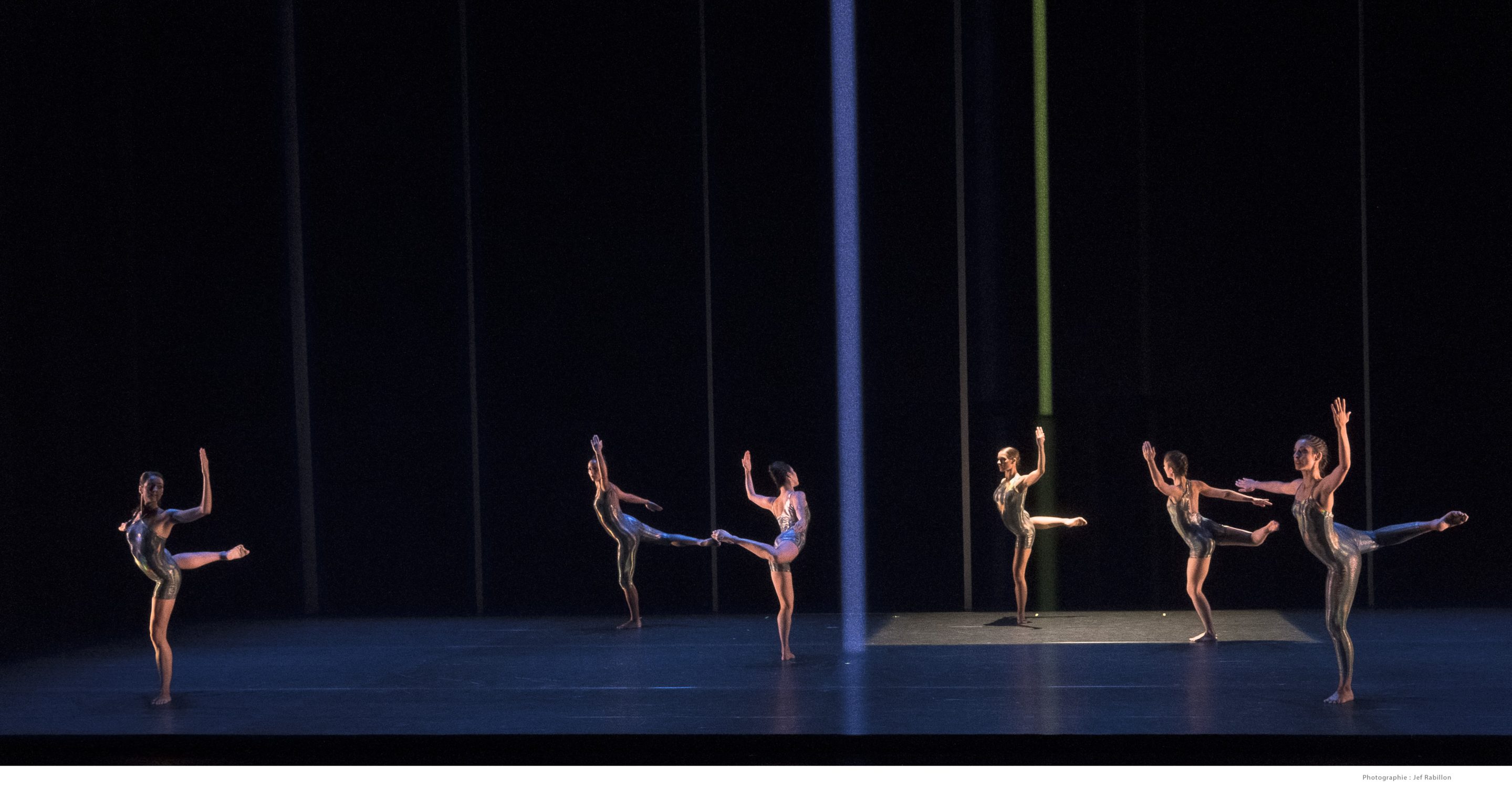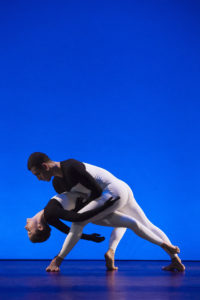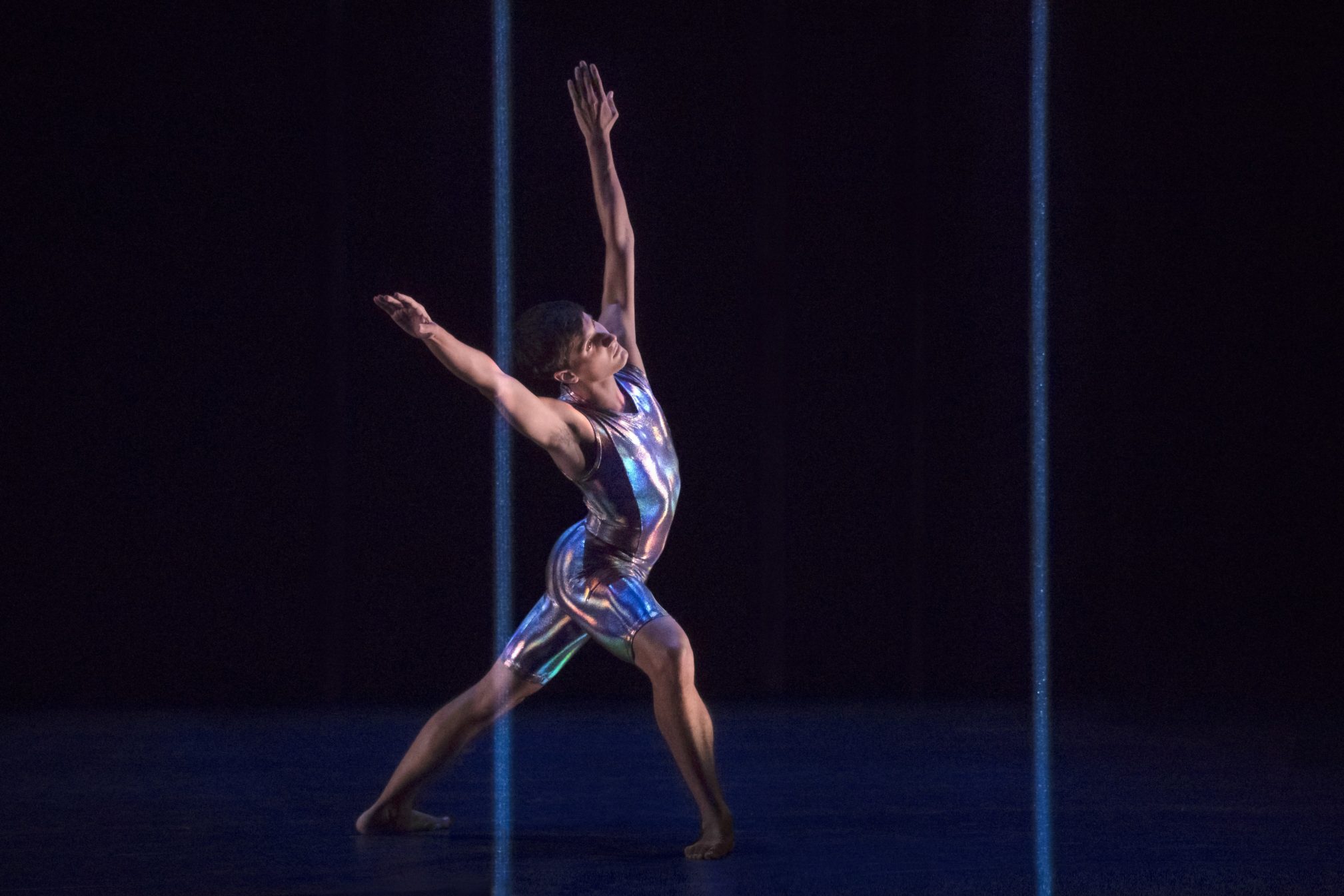What a pleasure to celebrate the centenary of modern dance master Merce Cunningham with a pair of works that demonstrates his formidable vision for dance, imbued with clarity of form and generosity of spirit, allowing each viewer to draw individual interpretation and meaning.

Cunningham, a one-time student and dancer with redoubtable mid-century modernist Martha Graham, died a decade ago and left a legacy plan that sent his eponymous company on a world tour then closed it down. A selection from his more than 200 choreographed works is now available for companies around the world to acquire, and most often the dances fall into the hands of ballet troupes, like The Washington Ballet, which last season did a valiant job of Cunningham’s duets, but, alas, they’re not modern dancers with the training to fully do the pieces justice.
And it isn’t easy for dancers to get the Cunningham technique just right. As elegant and balletic as it may appear, with fleet footed footwork, elongated arabesques and variable port de bras or arm positions, there’s also the use of the back and spine in ways that many dancers haven’t finessed – curving and tilted torsos with cantilevered legs and arms and quick changes of direction and weight make Cunningham dances particularly challenging.
This past Thursday evening at the Kennedy Center’s Eisenhower Theater, former Merce Cunningham Dance Company dancer and rehearsal director Robert Swinston introduced his young troupe of dancers from Compagnie Centre National de Danse Contemporaine—Angers, who are training in the technique.
The pair of works on the program — Beach Birds and BIPED — are from late in Cunningham’s career, 1991 and 1999, respectively, and they show an artist fully immersed in his aesthetic.

As the curtain rose on Beach Birds, the white backdrop glowed in pinkish orangey hues of a sunrise. Eleven dancers in silhouette, perched on two legs, hovered in their white body stockings splashed with black from fingers to arms and shoulders. Swinston remarked in the pre-performance chat that he thought they resembled penguins. For me, they looked like seagulls in flight, the black suggesting the darkened shadows underneath their wings. They twitch or tremor, barely perceptible movements — a head cocked, a wrist flutter — then they all plie — bend their knees — as if preparing to take flight. Beach Birds unfolds like an airborne flock of birds, constantly in motion, yet seemingly still as they soar, catching an air current. A pair or trio of dancers come together for a moment, break off, regroup, like birds alighting.
There’s an elegance in the dancers’ outstretched arms spreading wing-like, then bending an elbow. Complicated catch steps, small jumps and glides allow the dancers to rearrange themselves in the space accompanied by “Four3,” John Cage’s fluidly environmental sounding score. Played live by Gavin Bryars, Morgan Gott, Audrey Riley, and James Woodrow, the score suggests water and rain, surf and sand, in its shimmery rattles, gushing strings, percussion, and most significant, its pregnant pauses.
Both Cage and Cunningham valued silence and stillness and in Beach Birds those moments of quietude for the ear and the body are deeply reflective of the Cage-Cunningham aesthetic — any sound or no sound can be music and its corollary, any movement or no movement can be dance. And in these moments of pause, of quiet stillness — after the ongoing continuity of rippling and slicing arms, zigzagging and rushing feet and legs — Beach Birds comes to life. For a Cunningham dancer, stillness is the exact opposite of deadness; in fact, the bodies are enlivened and hyper-alert in these moments that serve as respite just as the beach does for those fortunate enough to spend a day amid sand, surf, and birds.

Ever the experimentalist, Cunningham collaborated with digital artists Paul Kaiser and Shelley Eshkar using motion capture technology to create BIPED. As the name suggests it’s in its most basic sense an exploration of the biped, the ambulatory two-legged body.
But, particularly in Cunningham’s latter works, there’s a tremendous amount of depth and richness in the confluence of the technological representation of the body in space set against the living breathing bodies of the dancers.
Eshkar and Kaiser place a scrim in front of the dancers on which they project a moving décor of lines and patterns. At first, the vertical and horizontal lines suggest the old fashioned staticky lines on a TV screen with bad reception. Here Cunningham’s sometimes quirky, sometimes rigorous technical demands on dancers — bending and curving torsos and complex arm and leg patterns — attain a lovely elegance. The 15 company members, ensconced in body-hugging iridescent gold costumes, stretch and bend themselves into beautiful configurations. The arabesques here are elongated, the torso not forced upright against the lifted back leg, so there’s a stretchy, reaching quality there as well as in leaps that are clear and precise but don’t allow for pyrotechnic trickery.
Gavin Bryars’ score combines pre-recorded elements with live playing by the ensemble on acoustic instruments and provides a rich, warm setting with some nearly aching symphonic suggestions in the instrumentals. A sense of mystery and spirituality imbues the work, especially with the black-draped stage that allows dancers to slip on and off as if by magic. One moment when a line of five dancers suddenly comes into view feels supernatural: how did they appear? And the entrances and disappearances along with the musical scoring lends an elegiac mood to the work. Dancers slip away as others continue the choreography, unnoticed, but remarkable nonetheless.
Central to the continued intrigue of BIPED is the tension between the real and the unreal or surreal or otherworldly evident in the start linear movements of the projected “bipeds,” motion captured dancers reduced just to the lines and points that appear and disappear on the scrim.
While BIPED was created in 1999, it feels prescient today, as we’re all wedded 24/7 to technology, living our lives virtually rather than IRL — in real life. It feels as if Cunningham anticipated the technological takeover and, in BIPED he was wrestling with what dance would mean and become when technology usurps inherent physicality, living, breathing, sweating bodies. BIPED, it seems, could have been his response. Here the live bodies, as beautiful and interesting and even imperfect as they are, are overshadowed and overrun — literally, the scrim is in front of the dancers — by the computerized simulations of dancers.
The dancers of CCNDC—Angers were mostly up to the challenge of finessing the demands of Cunningham technique, the elegant, swift legs, the often-non-sequitur arm and leg and torso combinations, the speed and stillness, the rigor and quirks of his movement modalities. Missing, though, from CCNDC—Angers was a preternatural alertness and attack, of which Cunningham was a master. He had an ever-so-slight cock of his head in advance of a big movement moment, or an ability to stay hyper-alert when still, ready, like a tiger, to pounce.
As a master dancer, choreographer, and creative spirit, Cunningham, with his process-breaking ideas about including chance and being open to the moment during his creative activities, continues to influence generations of contemporary dancers. What a lovely gift the Kennedy Center has given dance and arts lovers in celebrating the 100th anniversary of his birth with a company that is imbued with the Cunningham spirit.
Running Time: 110 minutes, including one intermission
Merce Cunningham at 100 plays through October 5, 2019, at The Kennedy Center Opera House, 2700 F St NW, Washington, DC. For tickets, call (202) 467-4600 or go online.




